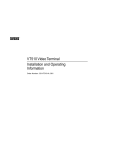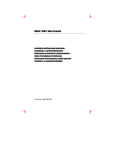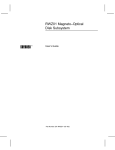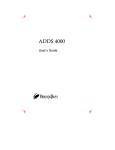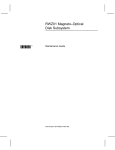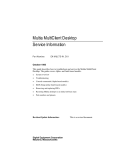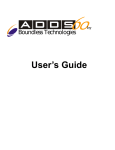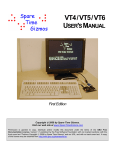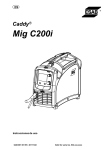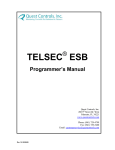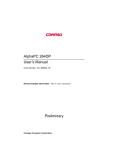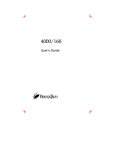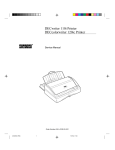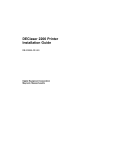Download Boundless VGB10 Instruction manual
Transcript
VT510 Video Terminal Installation and Operating Information Order Number: 598-0013866 November 1996 Boundless Technologies makes no representations that the use of its products in the manner described in this publication will not infringe on existing or future patent rights, nor do the descriptions contained in this publication imply the granting of licenses to make, use, or sell equipment or software in accordance with the description. DEC, OpenVMS, ULTRIX, VMS, and VT are trademarks of Digital Equipment Corporation. ADDS is a trademark of Applied Digital Data Systems, Inc. IBM, ProPrinter, and PS/2 are registered trademarks of International Business Machines Corporation. SCO is a trademark of Santa Cruz Operations, Inc. TVI is a trademark of TeleVideo, Inc. UNIX is a registered trademark of UNIX System Laboratories, Inc. WY and WYSE are registered trademarks of Wyse Technologies. All other trademarks and registered trademarks are the property of their respective holders. © Boundless Technologies, Inc. 1996-2009 All Rights Reserved. Printed in USA FCC ID: CR8-VGB10—NOTE: The North American version of this equipment has been tested and found to comply with the limits for a Class A digital device, pursuant to Part 15 of FCC Rules. These limits are designed to provide reasonable protection against harmful interference when the equipment is operated in a commercial environment. This equipment generates, uses, and can radiate radio frequency energy and, if not installed and used in accordance with the instruction manual, may cause harmful interference to radio communications. Operation of this equipment in a residential area is likely to cause harmful interference, in which case, the user will be required to correct the interference at his own expense. Canadian Standards Association (CSA) Statement This digital apparatus does not exceed the Class A limits for radio noise emissions from digital apparatus as set out in the radio interference regulations of the Canadian Department of Communications. Le présent appareil numérique n'émet pas de bruits radioélectriques dépassant les limites applicables aux appareils numériques de class A prescrites dans le règlement sur le brouillage radioélectrique édicté par le Ministère des Communications du Canada. Use of Ozone Depleting Substance (ODS) The VT510 is in full compliance with the labeling requirements in the US Clean Air Act Amendments of 1990. It does not contain, nor is it manufactured with, a Class 1 ODS, as defined in Title VI Section 611 of this act. chapter 1 Contents Preface Vv Overview ..................................................................................vv Environment ............................................................................vv Before you Start .......................................................................vv Conventions......................................................................... viivii Proper Setup and Use .......................................................... viivii 1 Installation and Set-Up 1-1 Install the tilt/swivel stand .................................................... 1-1 Install your terminal .............................................................. 1-2 Connect the cables to the terminal................................... 1-2 Plug in the power cord and push the power switch on...... 1-3 Set the Brightness and Contrast controls......................... 1-3 “Selftest OK” appears on the screen ................................. 1-3 Set up your terminal .............................................................. 1-4 Entering Set-Up............................................................... 1-4 Moving within a Set-Up Menu .......................................... 1-5 Keyboards.............................................................................. 1-5 Select the Set-Up language .................................................... 1-7 Select the emulation mode terminal type................................ 1-8 Select the keyboard language ................................................. 1-8 Select the communication/printer port configuration ............. 1-9 i ii Select the communication word size .......................................1-9 Select the communications parity.........................................1-10 Select the communication transmit speed ............................1-10 Select the communication receive speed ...............................1-11 Select the printer type ..........................................................1-11 Save your settings ................................................................1-12 Restore the settings .......................................................1-12 Exit the Set-Up menu ....................................................1-12 Desktop Features 2-1 Invoking Desktop Features .....................................................2-1 Overview ..........................................................................2-1 Clock feature ...................................................................2-2 Calculator feature ............................................................2-3 Show Character Sets feature ............................................2-4 Banner message...............................................................2-4 3 Maintenance and Troubleshooting 3-1 Cleaning your Video Terminal.................................................3-1 Cleaning the Screen .........................................................3-1 Cleaning the Keyboard .....................................................3-1 Troubleshooting .....................................................................3-1 Identifying and Correcting Problems.................................3-1 Troubleshooting Table......................................................3-2 Disposing of your Terminal.....................................................3-4 Installing the ROM Cartridge ..................................................3-4 Installing and Removing the ROM Cartridge .....................3-4 4 Defining Keys 4-1 Define Key Editor ...................................................................4-1 Moving Standard Functions .............................................4-1 Customization..................................................................4-2 Modifier Keys ...................................................................4-2 iii Creating a New Function.................................................. 4-2 Correcting a Mistake........................................................ 4-3 Examples of Uses............................................................. 4-3 A Specifications A-1 Video Terminal.......................................................................A-1 Acoustic Noise .......................................................................A-6 Flame Retardants...................................................................A-8 PVC .......................................................................................A-8 Asbestos ................................................................................A-8 Ozone Depleting Substance....................................................A-8 B Keyboard Function Keys B-1 User Definable Keys ...............................................................B-1 Local Functions .....................................................................B-1 Compose Characters ..............................................................B-6 chapter 1 0 Preface Overview This guide is for users who wish to install and configure the VT510 video terminal. This guide describes how to connect cables and enter the Set-Up Menu to make changes, as needed. This guide also has reference tables for troubleshooting, specifications, and compose sequences. For more detailed information on programming the terminal, refer to the VT510 Video Terminal Programmer Information. See the inside back cover for ordering information. Environment This product has been designed and manufactured to minimize the impact to the environment. The packaging is recyclable and the terminal can be returned for proper disposal. Before you Start Ensure that you have received the following: Video terminal Keyboard Power cord, if not attached to the terminal unit A small flat-blade screwdriver may be needed to install the communication or the printer cables. v vi Preface Obtain the following information before installing your VT510 video terminal. Write any changes to the default settings in the column on the right. Information Needed The keyboard country language that you have. Terminal Emulation: DEC VT, PCTerm, ADDS, SCO, TVI, WYSE Obtain From… Bottom of the keyboard System Manager Communication Information: Word size: 8 bits, 7 bits Parity: none, even, odd, mark, space System Manager Transmit speed: 9600 Printer Information: Printer type: DEC ANSI, IBM ProPrinter, DEC + IBM System Manager Printer serial speed: 4800 The factory defaults are in boldface type. Changes to Default Setting Conventions vii Conventions The following conventions are used in this document: Convention Meaning Shift+Tab Indicates two keys that you must press in combination. Press and hold the first key while you press the second key. Shift–Enter Indicates two keys that you must press in sequence. Press and release the first key before you press the second key. Caps Lock+Alt+F11 Indicates three keys that you must press in combination, hold the first two down while pressing the third. terminal Describes the VT510 video terminal Display Menu items are in boldface type. Provides general information Caution Provide information to prevent damage to equipment. Warning Provides information to prevent injury. Proper Setup and Use Important Information: Certain recent scientific literature suggests that poor posture, work habits, or office equipment setup may cause injuries. Other literature suggests that there is no cause and effect. Because the safety of our users is a great concern, it is important to take the precautions described in Table 1. viii Preface Table 1 Recommendations for Proper Setup and Use Adjust Chair Keyboard So that … 1 Feet are flat on the floor or footrest, if needed. 2 Legs are vertical forming a right angle to the floor. 3 Your weight is off your thighs and are in a horizontal position. Keep the back of your knees away from the seat so you do not compress the area behind them, which could restrict the blood flow. 4 Your upper body is erect and your lower back is supported with a backrest. 5 Your wrists are straight and do not flex more than 15°. They may be supported but should not rest on sharp edges. 6 Upper arms are straight down at your sides, elbows are close to your sides and support your arm weight. Forearms are at a 70° to 90° angle. Proper Setup and Use ix Table 2 (Cont.) Recommendations for Proper Setup and Use Adjust So that … Head 7 Your neck is not strained. Your head should incline downward, but no more than 15° to 20°. Terminal 8 Eye level and at the correct distance for proper vision. Eyes 9 Avoid eye fatigue, which can be caused by glare, image quality, uncomfortable furniture, eye height, and uncorrected vision. If you cannot read the screen at different distances, you may need special glasses. Relax your eyes periodically by looking at distant objects. Work Breaks Take periodic work breaks. Morning, lunch, and afternoon breaks meet most recommendations. Take advantage of work breaks to move around and do other movements. Noise Keep background noise at a minimum. Background noise above 65 dBA is tiring. Sound-absorbing materials, such as curtains, carpeting, and acoustic tile, can help reduce background noise. Lighting Avoid direct lighting or sunlight on the screen, which causes glare and reflections. This terminal screen has an antiglare treatment to reduce glare. Place lighting behind or to the side of your work area, and distribute the lighting evenly on your work area. Adjust the brightness and the contrast controls as needed. Temperature 20°C to 23°C (68°F to 74°F) Humidity 30% to 70% Ventilation Provide adequate air ventilation for equipment operation and to avoid fatigue. Space Between Terminals More than 70 cm (28 in.) enter to center, preferable more than 152 cm (60 in.). x Preface Warning: If you experience pain or discomfort during use of the terminal, then take a substantial break and review the instructions for posture and work habits. If the pain or discomfort continues after resuming use of the terminal, then discontinue use and report the condition to your job supervisor or physician. chapter 1 1 Installation and Set-Up Install the tilt/swivel stand 1. Carefully set the terminal face down. 2. Insert the hooks on the stand into the slots at the bottom of the terminal. 3. Slide the stand to the right until it is locked by the two tabs at the bottom of the terminal. (To remove the stand, press the two tabs.) 1-1 1-2 Installation and Set-Up Install your terminal Connect the cables to the terminal To install your terminal, connect the cable to the terminal as shown. Comm 1 (male or female), Keyboard, Power Cord. Parallel, Comm 2, Install your terminal 1-3 Plug in the power cord and push the power switch on The terminal will beep indicating that the power is on. Set the Brightness and Contrast controls If necessary, set the brightness and contrast controls by doing the following: 1. Set both controls to maximum by turning controls all the way to the right. 2. by turning the control to Adjust the brightness control the left until the background raster is not visible. This sets the black level. 3. by turning the control to the Adjust the Contrast control left to set the white level for conformable viewing. 4. Repeat steps 2 and 3 as needed. “Selftest OK” appears on the screen The terminal takes a few seconds to warm up and complete its power up self-tests. Then, the terminal should display “Selftest OK.” If a problem occurs, go to Chapter 3. 1-4 Installation and Set-Up Set up your terminal Use Set-Up to examine or change the terminal operating features, such as the transmit speed, receive speed, or the language, The Set-Up menus in this section will get you started in operating the terminal. Only the basic Set-Up feature is performed with this procedure. There are many more Set-Up features in the terminal that you may wish to change. Before changing the Set-Up features, contact your System Manager, if necessary, for information on the terminal type, terminal ID to host, and the communication settings. Printer operations are suspended upon entering Set-Up and are resumed upon exiting Set-Up. Entering Set-Up To enter Set-Up, perform the following procedure: On a … Press … Refer to … ANSI-style keyboard F3 Figure 1-1 PC keyboard Caps Lock+Print Screen or Caps Lock+Sys Rq Figure 1-2 Keyboards 1-5 Moving within a Set-Up Menu Use the arrow keys ( , , , ) to move among the menus or within a list or to select buttons. In a menu … Indicates … ? A pull-right menu is available. … A dialog box is available for you to specify more information. a b c The menu item with the filled-in circle is enabled. Only one of these items can be enabled at a time. The menu item with the check box is enabled. Press Enter, Return, Do, or Select to start the action or to choose the currently highlighted feature. A dimmed menu item does not apply to the currently selected mode. Keyboards A DEC VT keyboard (Figure 1-1) and a PC keyboard (Figure 1-2) differ in the placement of some of the keys, such as the arrow keys. A DEC VT keyboard has 20 function keys (F1 – F20) above the main keypad, while a PC keyboard has 12 function keys (F1 – F12). Keyboards from other manufactures may function differently because of differences in their implementation of the PC keyboard standard. 1-6 Installation and Set-Up Figure 1-1 – DEC VT Keyboard Layout Figure 1-2 – PC-Style Keyboard Layout Main keypad, Editing keypad, Numeric keypad, Escape key, Indicator lights. keys, Function Select the Set-Up language 1-7 Select the Set-Up language This language selection is for set up only and does not affect the keyboard, the character set, or the printer settings. As you make changes to some Set-Up parameters, the Set-Up summary line will reflect those changes. Actions Display Terminal type ASCII emulation Keyboard Communication Modem Printer Tabs …. Set-Up language ---------------------------------On-line Save settings Restore settings Exit Set-Up S1=comm1 9600N81 ISO Latin–1 English Fran ais Deutsch Espa² ol Italiano North American VT510 Port selected, Transmit speed (9600), Parity (N), Word size (8), Character set, Keyboard language, Emulation Stop bits (1), mode. 1-8 Installation and Set-Up Select the emulation mode terminal type Actions Display Terminal type ASCII emulation Keyboard Communication Modem Printer Tabs …. Set-Up language ---------------------------------On-line Save settings Restore settings Exit Set-Up Emulation mode Terminal ID to host VT default char set PCTerm character set 7-bit NRCS characters Transmit 7-bit controls Select the keyboard language Actions Display Terminal type ASCII emulation Keyboard Communication Modem Printer Tabs …. Set-Up language ---------------------------------On-line Save settings Restore settings Exit Set-Up VT Keyboard language PC Keyboard language Define key … Save key definitions Recall key definitions Lock key definitions Caps lock function Keyclick volume Warning bell volume Margin bell volume Keyboard encoding Auto repeat Data processing keys Application cursor keys Application keypad mode VT510 VT420 VT320 VT220 VT100 VT52 VT420 PCTerm WYSE 160/60 Native WYSE 160/60 PCTerm WYSE 50+ WYSE 150/120 TVI 950 TVI 925 TVI 910+ ADDS A2 SCO console Select the communication/printer port configuration Select the communication/printer port configuration Actions Display Terminal type ASCII emulation Keyboard Communication Modem Printer Tabs …. Set-Up language ---------------------------------On-line Save settings Restore settings Exit Set-Up Port select Word size Parity Stop bits Transmit speed Receive speed Transmit flow control Receive flow control Flow control threshold Transmit rate limit Fkey rate limit Ignore Null character Local echo Half duplex Auto answerback Answerback message Answerback canceled S1=comm1 S1=comm1 S1=comm2 S1=comm2 Select the communication word size Actions Display Terminal type ASCII emulation Keyboard Communication Modem Printer Tabs …. Set-Up language ---------------------------------On-line Save settings Restore settings Exit Set-Up Port select Word size Parity Stop bits Transmit speed Receive speed Transmit flow control Receive flow control Flow control threshold Transmit rate limit Fkey rate limit Ignore Null character Local echo Half duplex Auto answerback Answerback message Answerback canceled 8 bits 7 bits print=comm2 print=parallel print=comm1 print=parallel 1-9 1-10 Installation and Set-Up Select the communications parity Actions Display Terminal type ASCII emulation Keyboard Communication Modem Printer Tabs …. Set-Up language ---------------------------------On-line Save settings Restore settings Exit Set-Up Port select Word size Parity Stop bits Transmit speed Receive speed Transmit flow control Receive flow control Flow control threshold Transmit rate limit Fkey rate limit Ignore Null character Local echo Half duplex Auto answerback Answerback message Answerback canceled None Even Odd Even, unchecked Odd, unchecked Mark Space Select the communication transmit speed Actions Display Terminal type ASCII emulation Keyboard Communication Modem Printer Tabs …. Set-Up language ---------------------------------On-line Save settings Restore settings Exit Set-Up Port select Word size Parity Stop bits Transmit speed Receive speed Transmit flow control Receive flow control Flow control threshold Transmit rate limit Fkey rate limit Ignore Null character Local echo Half duplex Auto answerback Answerback message Answerback canceled 115.2K baud 76.8K baud 57.6K baud 38.4K baud 19.2K baud 9600 baud 4800 baud 2400 baud 1200 baud 600 baud 300 baud Select the communication receive speed Select the communication receive speed Actions Display Terminal type ASCII emulation Keyboard Communication Modem Printer Tabs …. Set-Up language ---------------------------------On-line Save settings Restore settings Exit Set-Up Port select Word size Parity Stop bits Transmit speed Receive speed Transmit flow control Receive flow control Flow control threshold Transmit rate limit Fkey rate limit Ignore Null character Local echo Half duplex Auto answerback Answerback message Answerback canceled Transmit speed 115.2K baud 76.8K baud 57.6K baud 38.4K baud 19.2.K baud 9600 baud 4800 baud 2400 baud 1200 baud 600 baud 300 baud Select the printer type Actions Display Terminal type ASCII emulation Keyboard Communication Modem Printer Tabs …. Set-Up language ---------------------------------On-line Save settings Restore settings Exit Set-Up Port select Print mode Printer type DEC/ISO char sets PC character sets Print extent Print terminator -----------------------------Serial print speed 2-way communication Transmit flow control Receive flow control Word size Parity Stop bits DEC ANSI IBM Proprinter DEC + IBM 1-11 1-12 Installation and Set-Up Save your settings Select the Save Settings menu item, the press Enter or Return. Caution: If you disable the Screen Saver feature, an image may etch onto the screen, which may shorten the terminal’s useful life. Restore the settings To recall the settings that you stored in memory using the Save Setting menu item, select the Restore Setting menu item and press Enter or Return. Restore factory defaults is a selection included in the Action menu. Exit the Set-Up menu To exit Set-Up, select the Exit Set-Up menu item or perform the following procedure: On a … Press … Refer to … ANSI-style keyboard F3 Figure 1-1 PC keyboard Caps Lock+Print Screen Figure 1-2 chapter 2 2 Desktop Features Invoking Desktop Features Overview From the Actions menu, you can invoke the Clock, Calculator, Show character sets, and Banner message features. When the feature is highlighted (displayed in reverse video), press Enter or Return to enable the feature. Actions Display Actions Terminal type ASCII emulation Keyboard Communication Modem Printer Tabs …. Set-Up language ---------------------------------On-line Save settings Restore settings Exit Set-Up Clear display Clear communications Reset terminal Restore factory defaults -----------------------------Clock Calculator Show character sets Banner message … While these desktop features are enabled, other terminal functions are disabled. Press Ctrl+Z, F10, Exit, or Esc to exit the feature. 2-1 2-2 Desktop Features Clock feature You can enable the Clock feature without entering Set-Up by pressing Caps Lock +Alt+F11 if you are not in an ASCII emulation mode. The current time is displayed in the status line if this feature is enabled. The format is HH:MM, followed by AM or PM if the 12hour format is selected. Use the following keys within the clock features: Key Function or Tab Go to next field. or Shift+Tab Go to previous field. or Move within a field. Return or Enter If desired, check the 24-hour format box. For example, before entering 13:00, enable 24-hour format. A or P For 12-hour format, set the time to morning by pressing A or P for afternoon. If the clock feature is enabled, then the alarm sounds for five seconds or until a key is pressed. Each alarm message can be up to 20 characters and will be displayed in the status line until a key is pressed. If the hourly chime is enabled, then the terminal will beep once every hour. In Set-Up, select the Save settings menu item to save the time format. The clock feature is disabled when the terminal is turned off. Invoking Desktop Features 2-3 Calculator feature You can enable the Calculator feature without entering Set-Up by pressing Caps Lock +Alt+F12 if you are not in an ASCII emulation mode. In addition to the numbers on the numeric keypad, you use the following keys within the calculator: Key Function H, O, or D Select hexadecimal H, octal O, or decimal D format. Arrow keys Move the position of the calculator on the screen. Shift Change the keypad display to allow selecting STO, RCL, 1/x, X2, and Insert Results. Alt Change the keypad display to hexadecimal and allow selecting keys A through F o the numeric keypad. C/E Clear the entry. STO Store the number in the display into memory. RCL Recall the number from memory and place it in the display. Shift–Enter Insert the result at the current cursor position after exiting the calculator feature. All calculator math operations have equal priority except 1/χ and χ2. If a result is wider than the display, then a rounded number will be displayed. The non-rounded result will continue to be used in subsequent calculations. The decimal point cannot be used with the hexadecimal mode. 2-4 Desktop Features Show Character Sets feature You can enable the Show character sets desktop feature without entering Set-Up by pressing Caps Lock +Alt+F10 if you are not in an ASCII emulation mode. When the character set is displayed, you can use the following keys with this feature: Key Function Next or Prev Page Up or Page Down Look through the available character sets. Shift–L Display the line drawing character set if you are using a VT character set. Shift–T Display the technical character set. Shift–Enter For the current character set, insert the highlighted character into text at the current cursor position, if you are using a VT character set. Banner message From the Actions menu, select Banner message … 1. Press Return or Enter to display a dialog box. 2. Enter our banner message. 3. Press the 4. Press Return or Enter to Return to the Set-Up menu. to select the OK button. chapter 3 3 Maintenance and Troubleshooting Cleaning your Video Terminal Cleaning the Screen Before cleaning the screen, set the terminal power switch to the off position and wait 20 seconds to let the static electricity dissipate. Clean the screen with a video screen cleaner. Cleaning the Keyboard If needed, wipe the keys with a soft cloth. Do not allow moisture to get under the keys. Troubleshooting Identifying and Correcting Problems The following can be sources of problems: Communications cables Host system Nearby power or electrical sources 3-1 3-2 Maintenance and Troubleshooting Troubleshooting Table Use Table 3-1 to identify and correct any problem areas. Table 3-1 Identifying and correcting problems Symptom Possible Cause Cursor or “Selftest Brightness or Contrast control OK” does not is set too low. display Screen is blank, but cursor is blinking. Suggestion Solution Increase the brightness and contrast control setting under the front of the terminal. Power cord is not connected. Connect the power cord to the power source and the terminal. Push the power switch in. There is no power. Use a function outlet. The terminal is faulty. Set the power switch to the off position and contact the service representative. Screen saver is active. Press any key. Signal cable is not connected. Reconnect the cable. Communications From the Communication menu item, choose Port select and check the port is not set setting for the cable connections. properly. Communication speed may be set incorrectly. Check the communication transmit speed, receive speed, and parity with you system manager; then match them to the Set-Up settings. The host system may be faulty. Contact your system administrator. Video is off center. The Earth’s magnetic field at your location may be causing the display to shift. From the Display menu item, choose Screen alignment. Troubleshooting 3-3 Table 3-1 (Cont.) Identifying and correcting problems Symptom Video display has moving dots and distorted lines. The display rolls or flickers. Possible Cause There is electromagnetic interference. Move and electromechanical device, such as a fan or a motor, away form the terminal or move the terminal. CAUTION: Before moving the system, turn the power off and wait 20 seconds to let the static electricity dissipate. Refresh rate is too low. From the Display menu item, choose Refresh rate and select 72 Hz. The terminal is faulty. Set the power switch to the off position and contact the service representative. The printer will not The printer print. power is not on. Modifier keys remain in effect after released. Suggestion Solution Turn on the power to the printer. The printer cables are not connected. Check the cables. Communication port is not set correctly. From the Communication menu item, choose Port select and match the setting to the connections on the terminal. If you have a serial printer, its speed may be set incorrectly. From the Printer menu item, choose Serial print speed and match the setting to the one in your printer manual. Accessibility aid enabled. Check keyboard indicator line for icon. This feature is enabled by pressing any key modifier key five times. To disable, press and hold a modifier key and then press another key. 3-4 Maintenance and Troubleshooting Disposing of your Terminal Warning: If you need to dispose of your terminal, ask a qualified service representative for the proper disposal procedures. Improper disposal could result in personal injury. Installing the ROM Cartridge The terminal can accommodate an optional ROM cartridge at the back of the terminal. This ROM cartridge will completely replace the factory-installed software within the terminal for new software versions or special applications. When an option ROM is not used, the ROM cartridge holder is empty with a cover over it. Installing and Removing the ROM Cartridge To install a ROM cartridge: 1. Set the power switch to the off position. 2. Remove the blank cover by lifting the cover from the bottom and gently pulling it straight back. 3. Plug in a ROM cartridge with its attached cover the cover. , and close Installing the ROM Cartridge If you are having the terminal serviced, then remove and save the ROM cartridge. To remove a ROM cartridge, lift its cover from the bottom and gently pull it straight back. 3-5 chapter 4 4 Defining Keys Define Key Editor The VT510 provides a powerful Define Key Editor that allows you to modify the function of keys on your keyboard. Since VT510 keystrokes can perform many different functions, it will take some practice to understand how the keys work. This section is an introduction to customizing your keyboard. Moving Standard Functions The simplest way to re-program a key is to copy the behavior of another key. This method allows you to move factory default key functions to any position on the keyboard. To move factory default key functions: 1. From the Keyboard menu item, select the Define key … function, and the Define Key Editor menu will appear. 2. Press the key for which you want to assign a new behavior. 3. Press the key to highlight the “Copy of key default” radio button (• Copy of key default) and press Enter. 4. Press the key whose factory default behavior is what you want your defined key to do. 5. Press the key to highlight the OK or Apply pushbutton and press Enter. 4-1 4-2 Defining Keys Customization If you want to program a key to behave differently than one of the factory defined keys, then you will need to know about the following VT510 key categories: Function: Keys used to transmit function key sequences or to perform local terminal functions such as the arrow keys ( , , , ), and Shift modifier keys, or the Set-Up key. Alphanumeric: Keys used to transmit alphanumeric characters. Modifier Keys Modifier keys vary from within the function and alphanumeric categories. A modifier key is a key that modifies the behavior of other keys when it is pressed and held down. For example, pressing an alphanumeric key in combination with the Shift modified key will normally send the shifted or uppercase characters for that key. Modifier keys are treated as a special kind of local terminal function. The VT510 function modifier keys are: Shift, Ctrl, and Alt. VT510 alphanumeric keys can also be modified by pressing Group Shift (Alt Gr on enhanced PC keyboards) and Alt+Shift (Shift-2). Modifier keys themselves cannot normally be modified by other keys. A key assigned to act as the Shift modifier, for example, cannot transmit a functions sequence when pressed in combination with the Alt key. Defining a key as a modifier key makes all assignable combinations of that key act as a modifier. Creating a New Function To define a new function key: 1. From the Keyboard menu item, select the Define key… function, and the Define key editor menu will appear. 2. Press the key for which you want to assign a new behavior. 3. Press the and keys to highlight the “Function” radio button (• Function) and press Enter. 4. Press the and keys to highlight the modifier combination that you want to define (unshifted, shifted, control, and so on) and press Enter. Define Key Editor 4-3 5. Press the key to move to the “Select function” scroll box. Press the and keys to highlight the desired keystroke function from the list and press Enter. 6. Press the 7. Repeat steps 4 through 6 to define other modifier combinations as desired. 8. Use the arrow keys ( , , , ) to highlight the OK or Apply pushbutton and press Enter. key to return to the modifier selection. Correcting a Mistake If you make a mistake or want to start over, select the Cancel pushbutton or select the Exit Set-Up menu item. Your changes will not be recognized until you select the OK or Apply pushbutton. To save your key definitions so they will be available the next time you turn on the system power, select the Save key definitions menu item for the Keyboard menu. Examples of Uses Examples of when to create new functions include: To change the ⌫ key to delete when unshifted and to backspace when shifted To disable the Compose, Break, or set-Up key by assigning them to have no function The Define Key editor can be very powerful if you take the time to learn how to use it. No matter how you define the keys, you can always enter Set-Up by pressing F3 after powering on. Additionally, you can always restore the factory default settings by invoking the Actions menu items. See the VT510 Video Terminal Programmer Information manual to redefine alphanumeric keys or keyboard layouts. appendix 5-4 Specifications A 5 Specifications Video Terminal The following are the specifications for the VT510 video terminal. Dimensions Height 32 cm (12.6 in) Width 31.5 cm (12.4 in) Depth 33 cm (13 in) Weight 7.9 kg (17.4 Ib) Tilt Range 25° (5° forward, 20° backward) Swivel Range ± 90° (left and right) Display Cathode ray tube (CRT) 35 cm (14 in) diagonal antiglare flatprofile screen Overscan 60 Hz – 16 x 10 font; 72 Hz – 13 x 10 font Area 800 x 432 pixels with 88 DPI density Usable area 17 cm (6.7 in) x 23 cm (9 in); 1:1.4 aspect ratio No. of lines 25, 42, or 53 data lines Page size Selectable 24, 25, 36, 42, 48, 50. and 72 lines (emulation dependent) Operating Systems Supported UNIX, MDOS, OpenVMS, OSF, ULTRIX, VMS, or any other that supports ASCII or ANSI protocols. Video Terminal 5-5 Terminal Emulations ANSI, PCTerm, and ASCII emulations: VT, WYSE. TVI, ADDS, or SCO console. Character Set Support Multiple languages using ISO and IBM code pages; Set-Up selectable in five languages Productivity Features Local copy and paste Time-of-day clock—sound alarms and display messages Desktop calculator—insert result into text Show character sets—insert character into text. ROM cartridge support 4-Mbit (512 K byte) customer- installable ROM cartridge at back of system unit that completely replaces the factory installed ROM code for new versions of the terminal’s firmware Electrical Requirements AC input voltage Line frequency Power consumption 120 Vac only; or 110, 120, 220, 330, 240 auto-sensing (product variant) single phase, 3-wire 47 Hz to 63 Hz 40 watts maximum Operating Temperature 10°C to 40°C (50°F to 104°F) Humidity 10% to 90% relative humidity Maximum wet bulb = 28°C Minimum dew point = 2°C (noncondensing) Keyboard The following are the specifications for the keyboard. LK411/LK412 for ANSI/ANSI WPS style layout; PCXAL for enhanced PC 101/102 style layout; available for most European languages. IBM enhanced PS/2-compatible Keyboard style Protocol Connector Keyboard keys Nonvolatile memory PS/2-style, 6-pin mini DIN All keys are programmable for single characters, character sequences, or local functions. 768K bytes memory 5-6 Specifications Cables User-defined key maximum length = 255 bytes The following are the specifications for the cables. Order Number Length* Connectors EIA-232 Serial Communications/Printer Cables BC22E-10 BC22E-25 3 m (10 ft.) 7.6 m (25 ft.) 25-pin D-sub f to 25-pin D-sub m BC22D-xx xx† 25-pin D-sub f to 25-pin D-sub f EIA-422 Communications Cables BC16E-10 BC16E-25 3 m (10 ft.) 7.6 m (25 ft.) Parallel Printer Cables BC19M-10 3 m (10 ft.) 6-pin MMJ to 6-pin MMJ 25-pin D-sub m to 25-pin D-sub m * EIA-232 maximum cable length is 15.3 m (50 ft.); EIA-423 maximum cable length is 305 m (1000 ft). † xx = length in feet (10, 25, 50) Communication/Printer Ports Serial Bidirectional serial communication/ printer ports with full modem support at 300 to 115.2K baud: EIA 423 Comm1 (Figure A-1): Two 25-pin D-sub m/f (use one or the other) EIA 232 Comm2 (Figure A-2): 6-pin MMJ Parallel m = male; f = female Centronics (25-pin D-sub f) parallel printer connector (Figure A-3). Video Terminal CCITT/EIA/DIN 1 1 GND/NC 1 2 TXD 3 RXD 4 RTS 5 CTS 6 DSR 7 SIG GND 8 CD 12 SI 20 DTR 23 SPD SEL 9-11, 13-19, 21, 22, 24, 25 NC 103/BA/DI 104/BB/D2 105/CA/S2 106/CB/M2 107/CC/M1 102/AB/E2 109/CF/M5 112/CI 108.2/CD/S1.2 111/CH/S4 Figure A–1 Comm1—Serial Communication/Printer Portsl 1 2 3 4 5 6 DTR TXD + TXD – RXD – RXD + DSR Figure A–2 Comm2—MMJ Port 1 In North America, pin 1 is open; in international units, pin 1 is ground. NC = Not connected. 5-7 5-8 Specifications 1 2 3 4 5 6 7 8 9 STROBE L DAT<0> DAT<1> DAT<2> DAT<3> DAT<4> DAT<5> DAT<6> DAT<7> 10 ACKNLG L 11 BUSY 12 PE 13 SLOT 14 AUTO FEED XT L 15 ERROR L 16 INIT L 17 SLCT IN L 18–25 GND Figure A–3 — Parallel Printer Port Power Cords The following are the specifications for the power cords. Order Number Country Amp Length BN19H-2E Argentina, Australia, New Zealand 15A 3.5 m BN19W-2E Central Europe 15A 2.5 m BN19W-2E Brazil, Chile, Columbia, Paraguay, Uruguay 15A 3.5 m BN19P-2E BN19P-03 Canada, U.S. 15A 1.9 m 3.0 M BN19K-2E Denmark 15A 2.5 m BN19A-2E Ireland, United Kingdom 15A 2.5 m BN19S-2E India, South Africa 15A 2.5 m BN18L-2E Israel 15A 2.5 m BN19M-2E Italy 15A 2.5 m BN24T-2E Switzerland 15A 2.5 m BN26J-1K or Bolivia, Colombia, Ecuador, (17-00083-xx) * Mexico, Venezuela * 1.9 m * xx = -38 = 125V, 13A -39 = 125V, 15A -40 = 250V, 10A -41 = 250V, 10A Acoustic Noise 5-9 Acoustic Noise Preliminary declared values per ISO 9296 and ISO 7779: Product Sound Power Level Sound Pressure Level2 L wAd, B L p A m , dBA 1 Idle Operate Idle Operate VT510 <3.9 <3.9 <22 <22 PCXAL NA 6.0 NA 51 PC7XL NA 5.3 NA 47 LK411 NA 5.6 NA 52 1 2 Current values for specific configurations are available from Boundless representatives (1 B = 10dBA.) Operator position. Agency Type Standard Subject CSA Safety CSA 22.2 #950 M1989 Safety of Information Technology Equipment Including Electrical Business Equipment (Canada) CSA 22.1 Canadian electrical code CISPR-22 EMI/RFI CISPR-22 Class A Electromagnetic compatibility EIA Telcom EIA 423 EIA 232-E Serial communications DOC Canada EMI/RFI CSA 108.8 North American Class A version FCC FCC part 15 Class B Electromagnetic compatibility Australia PPT Telecom German PPT Japan PPT Sweden PPT CCITT V.24 and V.28 Serial communications Australia AS3260 Australia product safety EMI/RFI Safety 5-10 Specifications Agency Type Standard Subject TUV Safety EN60950 (2nd ed, 1988) EN60950 (Amd 1 & 2, 1990) IEC950( 2nd ed, 1991) German X-Ray Act RöV §5(2) EMKO-TSE (74SEC) 203/92 SS 436 14 90, MPR II Safety of Information Technology Equipment Including Electrical Business Equipment GS-Marl (Geprüfte Sicherheit) TUV Ergonomic ISO/DIS 9241-3 VDT Ergonomic Requirements UL Safety UL 544 (2nd ed) Standard for Medical and Dental Equipment UL 1950 (1st ed) Safety of Information Technology Equipment Including Electrical Business Equipment NFPA 70 U.S. National Fire Protection Agency - National Electrical Code Vfg 243/1991 Radio Protection Mark VDE EMI/RFI EN55022 class B VCCI (Japan) EMI/RFI Class 1 Electromagnetic compatibility Flame Retardants 5-11 In addition to the standard listed previously, the VT510 low-emissions video terminal complies with the following standards: Agency Type Standard Subject NBOSH EMI/RFI MPR-2 1990:8 Swedish National Council for Metrology and Testing Display Units EMI/RFI SS 436 14 90 Swedish standard for low emissions Flame Retardants The thermoplastic enclosures do not contain polybrominated diphenylether (PBDE) as a flame retardant additive; therefore, they do not emit toxic dibenzofuran and dibenzodioxin gases. PVC The plastic enclosures are not made of rigid PVC. The material has a non-halogenated, flame-retardant system and is cadmium free. Asbestos Asbestos is not used in this product or in its manufacturing process. Ozone Depleting Substance The VT510 is in full compliance with the labeling requirements in the U.S. Clean Air Act Amendments of 1990. It does not contain, nor is it manufactured with a Class 1 ODS, as defined in Title VI Section 611 of this act. appendix B 6 Keyboard Function Keys User Definable Keys All keyboard keys are programmable by selecting the Define key function from the Keyboard menu item in Set-Up. They can be programmed to send single characters or character sequences, or to invoke a local function, such as Print Screen. The function keys have the following key levels: Unshifted, Shifted, Control, Shift Control, Alt, Alt-Shift, Alt-Control, and Alt-Shift-Control. Local Functions The keys used to perform local terminal functions differ between the VT keyboard, PC keyboard, and the mode selection. Table B-l shows the corresponding keys for the default local functions and their function number. This number is used in the DECPAK’s host sequence or DECPAK's alternate function to specify a change to that Local Function key. Table B-2 lists other available local functions. 6-1 6-2 Keyboard Function Keys Table B-1 Local Functions Function Number Function VT Keyboard SCO Console PC Keyboard VT-Style PC Keyboard PC-Style PC Keyboard SCO 0 no function 1 Hold F1 Lock+F1 F1 Scroll Lock 2 Print F2 Lock+F2 F2 Print Screen 3 Set-Up F3 Lock+F3 F3 Lock+Print Screen Lock+Sys Rq Alt+Print Screen 5 Break F5 Lock+F5 F5 Lock Pause 7 Hard Reset Ctrl+F3 Lock+Ctrl+F3 Ctrl+F3 Ctrl+Lock+ Print Screen 8 Toggle Autoprint Ctrl+F2 Lock+Ctrl+F2 Ctrl+F2 Ctrl+Print Screen 9 Disconnect Shift+F5 Lock+Shift+F5 Shift+F5 Shift+Lock+Pause 10 Send Answerback Ctrl+F5 Lock+Ctrl+F5 Ctrl +F5 Ctrl+Lock+Pause 11 Print Composed Main Display Shift+F2 X Shift+F2 Shift+Print Screen X 20 Pan Up Ctrl+ X Ctrl+ Ctrl+ X 1 21 Pan Down Ctrl+ X Ctrl+ Ctrl+ 24 Pan Prev Page Ctrl+Prev X Ctrl+Page Up Ctrl+Page Up 25 Pan Next Page Ctrl+Next X Ctrl+Page Down Ctrl+Page Down 30 Copy & Paste Mode F1 (hold down) Caps Lock+F1 F1 Scroll Lock X means the function is not available in the default SCO state. If there is no “X” in the SCO Console column, then this means that the key sequence is the same as the VT Keyboard column. If there is no “X” in the PC Keyboard SCO column, then this means that the key sequence is the same as the PC Keyboard PC-Style column. 1 Lock means the Lock key, Caps Lock key, or key with lock icon. Local Functions 6-3 Table B-1 (Cont.) Local Functions Function Number Function VT Keyboard SCO Console PC Keyboard VT-Style PC Keyboard PC-Style 31 C&P Cursor Left 32 C&P Cursor Down 33 C&P Cursor UP 34 C&P Cursor Right 35 C&P Start Selection Select Home Home 36 C&P Copy Remove End End 37 C&P Paste Insert Here Insert Insert x± 38 C&P Left-to-Right Select Home Home 41 Shift Modifier Left or right Shift Left or right Shift Left or right Shift 42 Control Modifier Ctrl Left or right Ctrl Left or right Ctrl 43 Alt Function Modifier Left or right Alt Left or right Alt Left or right Alt 44 Start Compose Left or right Compose 45* Group Shift Modifier Group Shift ± Left Alt+Space Alt+Gr Alt+Gr means the function switches alternately between on and off. C&P means Copy and Paste. PC Keyboard SCO 6-4 Keyboard Function Keys Table B-1 (Cont.) Local Functions PC Keyboard PC-Style PC Keyboard SCO Lock+Alt+Ctrl+ Ctrl+Alt+F1 F1 Ctrl+Alt+F1 See SCO Console Lock+Alt+Ctrl+ Ctrl+Alt+F2 F2 Ctrl+Alt+F2 See SCO Console SCO Console PC Keyboard VT-Style Function Number Function VT Keyboard 46† Shift2 Modifier Alt Shift 47 Primary KB language Ctrl+Alt+F1 48 Secondary KB language Ctrl+Alt+F2 49‡ ±KB language 51 ±Caps Lock State Lock Lock Lock 52 ±Num Lock State Num Lock Num Lock 53 ±VT/IBM Style Lock Num Lock Lock Num Lock 54 Extend Kbd Modifier Lock Lock X 61 Screen saver 62 Calculator Lock+Alt+F12 Lock+Alt+ F12 Lock+Alt+F12 63 Clock Lock+Alt+F11 Lock+Alt+ F11 Lock+Alt+F11 64 Character table Lock+Alt+F10 Lock+Alt+ F10 Lock+Alt+F10 65 Transfer results Shift Enter Shift-Enter Shift-Enter X The Shift2 Modifier is assigned to the Alt Shift key (German “Right Compose”) when it appears on the corresponding keyboard (German). † ‡ Toggles KB language is assigned to the named language key when it appears on the corresponding keyboard (Greek, Hebrew, and Russian). ± means the function switches alternately between on and off. C&P means Copy and Paste. Lock means the Lock key, Caps Lock key, or key with lock icon. Local Functions Table B-2 Function Number 91 92 93 94 100 105 106 111 112 113 114 115 116 117 119 6-5 Other Available Local Functions Function BS CAN ESC DEL UDK sequence Soft reset ±Show controls ±Status display ±Split screen Raise horizontal split Lower horizontal split Adjust window to show cursor ± Cursor drag ± Insert mode Home & Clear Function Number 120 121 122 123 124 125 126 138 139 142 144 151 155 156 157 Function Page 0 Page 1 Page 2 Page 3 Page 4 Page 5 Page 6 Prev Page Next Page Slow Scroll Fast Scroll ±Keyclick ±Block mode Block mode on Block mode off ± means the function switches alternately between on and off. An Accessibility aid feature allows the modifier keys to remain in effect after they are released. A small icon in the status line indicates its state. To enable: Press any modifier key five times. To disable: Press and hold a modifier key while you press another key. 6-6 Keyboard Function Keys Compose Characters The tables at the end of this manual describe how to compose characters for the Multinational and ISO Latin 1 character sets for a VT keyboard. In the tables, column ... Represents ... Characters to be composed. 3- A three-stroke key sequence beginning with the Compose key. 2- A two-stroke key sequence beginning with a non-spacing diacritical accent key. Within the tables… Represents ... (sp) A space character. Canadian-English Danish, Dutch, Hebrew, Hungarian, Italian, Norwegian, Polish, Romanian, Russian, SCS, Turkish-F, Turkish-Q, UK, and US keyboards do not have non-spacing diacritical marks regardless of the character mode. Contact Boundless Tech Support 1916 Route 96 Phelps, NY 14532-9705 Toll Free 1-800-231-5445 Phone (315) 548-6189 Fax (315) 548-5100 email [email protected] web www.boundlessterminals.com




















































